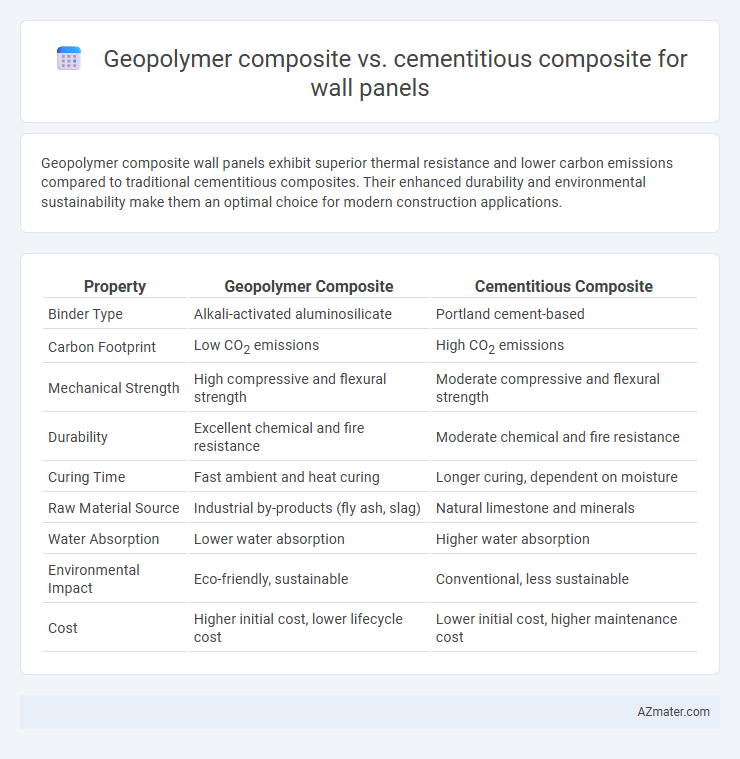Geopolymer composite wall panels exhibit superior thermal resistance and lower carbon emissions compared to traditional cementitious composites. Their enhanced durability and environmental sustainability make them an optimal choice for modern construction applications.
Table of Comparison
| Property | Geopolymer Composite | Cementitious Composite |
|---|---|---|
| Binder Type | Alkali-activated aluminosilicate | Portland cement-based |
| Carbon Footprint | Low CO2 emissions | High CO2 emissions |
| Mechanical Strength | High compressive and flexural strength | Moderate compressive and flexural strength |
| Durability | Excellent chemical and fire resistance | Moderate chemical and fire resistance |
| Curing Time | Fast ambient and heat curing | Longer curing, dependent on moisture |
| Raw Material Source | Industrial by-products (fly ash, slag) | Natural limestone and minerals |
| Water Absorption | Lower water absorption | Higher water absorption |
| Environmental Impact | Eco-friendly, sustainable | Conventional, less sustainable |
| Cost | Higher initial cost, lower lifecycle cost | Lower initial cost, higher maintenance cost |
Introduction to Geopolymer and Cementitious Composites
Geopolymer composites, derived from aluminosilicate materials activated by alkaline solutions, offer enhanced durability, fire resistance, and lower carbon footprint compared to traditional cementitious composites, which rely on Portland cement hydration. These composites exhibit distinct microstructures and chemical bonding mechanisms, influencing their mechanical performance and environmental impact in wall panel applications. Geopolymer composites present a sustainable alternative by reducing CO2 emissions and improving thermal stability, while cementitious composites remain widely used due to their established production methods and material availability.
Material Composition and Chemistry
Geopolymer composites utilize aluminosilicate materials such as fly ash or metakaolin activated by alkaline solutions, resulting in a three-dimensional polymeric network with enhanced durability and chemical resistance. Cementitious composites primarily consist of Portland cement hydration products like calcium silicate hydrate (C-S-H) gel, providing traditional strength but with higher carbon emissions and susceptibility to chemical degradation. The distinct chemical mechanisms in geopolymers offer lower environmental impact and improved thermal stability compared to the calcium-based chemistry dominating cementitious composites used in wall panels.
Environmental Impact and Sustainability
Geopolymer composites for wall panels significantly reduce carbon emissions by utilizing industrial by-products like fly ash and slag, offering a sustainable alternative to traditional cementitious composites that rely heavily on energy-intensive Portland cement. Their lower embodied energy and enhanced durability contribute to extended lifecycle performance and reduced environmental footprint. Furthermore, geopolymer composites promote circular economy principles by repurposing waste materials, minimizing landfill use and conserving natural resources compared to conventional cementitious panels.
Mechanical Properties Comparison
Geopolymer composites exhibit higher compressive strength and improved fracture toughness compared to traditional cementitious composites, making them more suitable for load-bearing wall panels. Their enhanced durability and resistance to chemical attack contribute to better long-term mechanical performance in varied environmental conditions. Furthermore, geopolymer composites demonstrate superior flexural strength and reduced shrinkage, which minimize cracking and improve structural integrity in wall panel applications.
Durability and Long-Term Performance
Geopolymer composites exhibit superior durability compared to cementitious composites due to their enhanced resistance to chemical attacks, sulfate exposure, and high-temperature conditions, making them ideal for wall panels in harsh environments. The long-term performance of geopolymer composites benefits from lower shrinkage and reduced cracking, contributing to increased structural integrity and lifespan over traditional cementitious materials. Their superior fire resistance and lower permeability further ensure sustained mechanical properties and reduced maintenance costs throughout the service life of wall panels.
Thermal and Acoustic Insulation
Geopolymer composites exhibit superior thermal insulation properties compared to cementitious composites, due to their lower thermal conductivity, which reduces heat transfer in wall panel applications. Acoustic insulation is enhanced in geopolymer composites by their porous microstructure, effectively dampening sound waves better than the denser cementitious panels. These characteristics make geopolymer composites a more efficient choice for energy-saving and noise-reducing wall panels in building construction.
Fire Resistance and Safety
Geopolymer composites exhibit superior fire resistance compared to cementitious composites, maintaining structural integrity at temperatures exceeding 1000degC due to their inorganic polymer matrix. Their inherent non-combustibility and low thermal conductivity enhance safety by reducing flame spread and smoke emission in wall panels. Incorporating geopolymer composites in wall panels significantly improves fire safety standards while providing durable, sustainable construction solutions.
Workability and Construction Methods
Geopolymer composites offer superior workability compared to cementitious composites due to their lower water-to-binder ratio and enhanced flow properties, which facilitate easier mixing and molding for wall panel applications. Construction methods for geopolymer wall panels often involve ambient temperature curing, reducing the need for energy-intensive processes typical of cementitious panels that require longer curing times and higher moisture control. These characteristics lead to faster installation and reduced labor costs, making geopolymer composites a sustainable alternative for prefabricated and in-situ wall panel construction.
Cost Analysis and Economic Viability
Geopolymer composites for wall panels generally offer lower lifecycle costs compared to traditional cementitious composites due to reduced energy consumption during production and lower raw material expenses, especially when utilizing industrial byproducts like fly ash or slag. Economically, geopolymer panels demonstrate enhanced viability in regions with high cement prices or strict carbon regulations, as they reduce greenhouse gas emissions and potentially qualify for sustainability incentives. Initial manufacturing costs of geopolymers may be higher, but long-term savings from durability and reduced maintenance make them a cost-effective alternative in sustainable construction markets.
Future Prospects and Industry Applications
Geopolymer composites for wall panels offer superior fire resistance, lower carbon footprint, and enhanced durability compared to cementitious composites, positioning them as a sustainable alternative in the construction industry. Their application in infrastructure, commercial buildings, and precast elements is growing due to increasing demand for eco-friendly materials and regulatory pressures to reduce CO2 emissions. Advances in raw material sourcing and mix design optimization continue to improve the performance and cost-efficiency of geopolymer composites, expanding their potential for widespread industrial adoption.

Infographic: Geopolymer composite vs Cementitious composite for Wall panel
 azmater.com
azmater.com